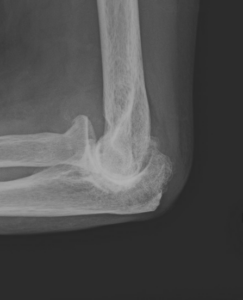Elbow Replacement/Arthroplasty Surgery
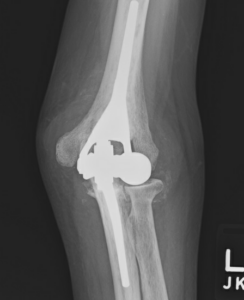
Elbow Replacement Surgery
View from the front to the back
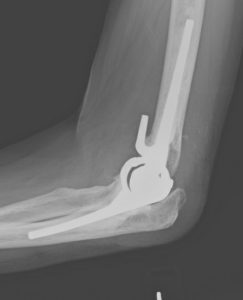
Elbow Replacement Surgery
View from the side
Your Diagnosis
An elbow replacement surgery is done to help people with elbow arthritis. See Elbow Arthritis section.
What happens during Surgery?
Surgery takes 1 to 2 hours. It is done with general anesthesia meaning the person is asleep. Usually the person will have a nerve block placed in their neck which makes their shoulder and arm numb for 6 to 48 hours. During surgery an 8 inch incision is made over the back of the elbow. Your surgeon will removed the arthritic joint and replace it with a metal and plastic hinge.
Immediately after Surgery
The person will wake from surgery in the recovery room where they will spend 1 to 3 hours. Later they will be transferred to their room and typically will spend 1 night in the hospital. The person may notice that they cannot feel or move their arm, hand and fingers. This is because of the nerve block and is normal.
A person may have questions following your surgery. Many of these frequently asked questions surgery questions can be answered here.
Therapy after Surgery
After elbow replacement surgery, an intense therapy program is started right away. This therapy program involves stretching the elbow with the help of the other arm. The person will meet with a therapist, who will teach them Elbow Stretching.
What to expect after Surgery: week 0 through week 6
- Pain: Right after surgery, the elbow will hurt. Pain is expected. If the person is allowed to go home they will be given pain medications for home. If the person stays 1 night in the hospital they will be given oral pain medications and in the vein (IV) as needed. The pain medications will help with the pain but will not remove all of the pain. By day 5 after surgery almost all people have stopped taking the pain medication. It is important to stop taking the pain medications because pain at the repair site is protective. People who continue to take the pain medications have a much greater chance of the surgery not working.
- Therapy: Formal therapy and a home program for elbow range-of-motion is usually started right away.
- Precautions: The arm is to be kept in a sling as desired by the person. The person can come out of the sling at any time. The person will be asked not to lift anything over 5 pounds or 2 pounds repetitively.
- Work: Most people will need to take some time off work to do the therapy.
What to expect after Surgery: week 6 through week 12
- Pain: Most people have very little pain while resting. There will be pain with therapy and stretching. Many people have less pain than they had before surgery.
- Therapy: Therapy for stretching is continued. Therapy for strengthening is begun.
- Precautions: The precautions of no lifting anything heavier than 5 pounds or 2 pounds repetitively will be continued for life.
- Work: Most people with desk jobs have returned to work by week 6. People who have this surgery cannot work as a manual laborer.
What to expect after Surgery: week 12 through 1 year and beyond
- Pain: Most people will have less pain than they did before surgery.
- Therapy: Most people are no longer doing therapy.
- Precautions: The precautions of no lifting anything heavier than 5 pounds or 2 pounds repetitively will be continued for life.
- Work: Most people with desk jobs have returned to work by week 6. People who have this surgery cannot work as a manual laborer.
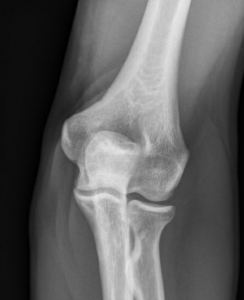
Normal Elbow
View from the front to back
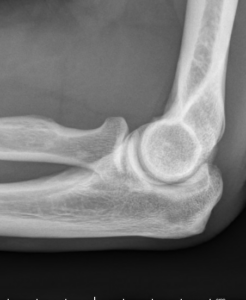
Normal Elbow
View from the side
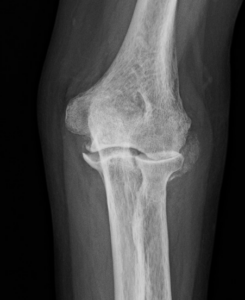
Elbow with Arthritis
View from the front to back
